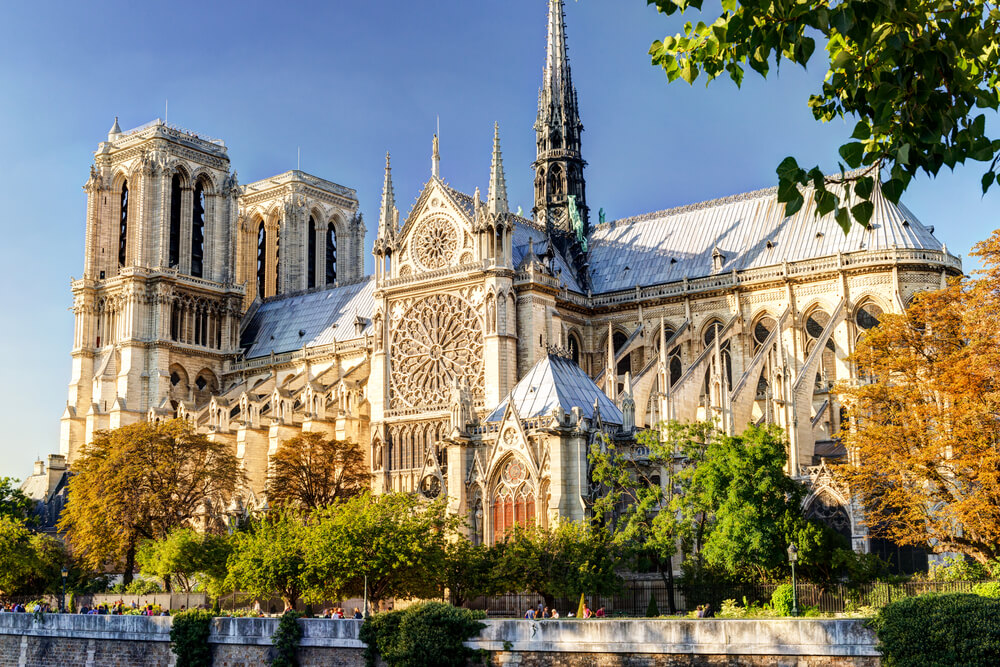On Monday, people around the world stood shocked as Notre Dame Cathedral in Paris was engulfed in flames. Footage of the cathedral’s iconic spire collapsing was like a punch to the gut, and as the fire raged it looked as though the entire structure would be lost.
Although the roof of the cathedral collapsed, it appears that the outside structure and much of the interior was spared. The Blessed Sacrament and the relics contained in the cathedral – including parts of the True Cross, Christ’s Crown of Thorns, and the Nails of the Crucifixion – were rescued from the flames.
But why was the potential loss of Notre Dame felt so strongly by Catholics and non-Catholics alike? Msgr. Stuart Swetland, host of Go Ask Your Father™ stopped by The Drew Mariani Show™ on Monday, while the fire was still raging, to discuss the significance of Notre Dame and what it means to the world.
One reason that the damage done to Notre Dame was felt so strongly is that it is a place that holds many cherished memories. Several listeners called in to The Drew Mariani Show to share how visiting Notre Dame was a part of their journey into the Catholic Church, and Msgr. Swetland offered his own personal connection to the cathedral.
“It’s hard for me not to tear up,” he told guest host Wendy Wiese. “It was one of my mom’s favorite places. I had the good fortune of taking her twice to the Cathedral. The first time when I was at Oxford as a student, and my parents were able to visit for their 25th wedding anniversary. And then close to the end of her life, I was able to take my mom there while she was on her way into the Catholic Church. So I have fond personal memories of my many visits there.”
Even for those who had never set foot in Notre Dame, the cathedral, built in 13th century, has been cherished for its Gothic architecture, it’s rose windows, and how it has stood the test of time. And with an average of 30,000 visitors each day, Notre Dame is an example of the human desire for transcendence, an image of Christ’s words that He will draw all men to Himself.
“In front of the cathedral would be a place where you really would see people from all over the world cross,” Msgr. Swetland said. “On occasions, you see the whole world pass by in many ways. And so it is just that, a symbol and a crossroads.”
But, of course, Notre Dame Cathedral is not merely a symbol or a tourist destination. It is the house of the Lord, and worship is at the heart of all that takes place there. From the art and the architecture that draws one’s gaze toward heaven, to the sacraments offered there that bring heaven to earth, worship is the raison d’etre for Notre Dame. With four Masses offered each weekday and five on Sunday, and Confession offered in eight languages for hours each day, countless souls have encountered the Lord within the walls of Notre Dame.
“I’ve con-celebrated Mass twice there and was the celebrant once for an English Mass there,” Msgr. Swetland recalled. “And it’s such a stunning place to say Mass, because of all the history that is involved. And that’s what I think of, the people of France, who are so used to this. This is their home church, if you will.”
Amidst the devastation of the fire, a beautiful site that captivated the world was the sight of Parisians gathered in prayer, singing hymns as they watched their spiritual home burn. Especially at the beginning of Holy Week, this image was a reminder that Christ died for each and every person there, and that each of them is more beautiful in His eyes than one thousand Notre Dames.
While the damage done to Notre Dame is not as bad as initially expected, it will be a long road of rebuilding. French President Emmanuel Macron has pledged to rebuild the cathedral, and Catholics will once again offer their gifts to make a beautiful home for the Lord.
“We will survive and we will go on. I’m sure that the people of France will survive and go on,” said Msgr. Swetland. “And we will pick up the pieces and start building again, as Christians always, everywhere have been asked to do.”

